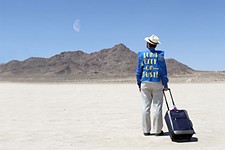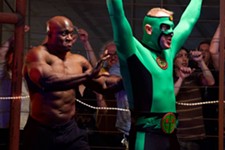Super-8's Super Fans
Cinemaker Co-op: Educating Tomorrow's Filmmakers Today
By Marc Savlov, Fri., Sept. 3, 1999

When I was a kid growing up in a dinky little suburb of Rochester, New York, I vividly recall stumbling across a cache of my father's old film equipment secreted away in our spacious, chilly, and forbiddingly dank basement. Nestled amongst a dusty, old med-school microscope and a glut of Sixties-era ski gear that would send Picabo Street fleeing in terror, was a blue Pan Am Airlines duffel loaded with old camera gear. Tucked in the bottom was a beige Kodak Super-8 camera with frame advance, one of their mid-Sixties models I assume, and doubtless the same one that had captured my first, wildly humorous attempt to consume lime Jell-O, circa 1969. Intrigued, I spent the better part of the summer struggling to re-create the stop-motion wizardry of Ray Harryhausen and Willis O'Brien via a gaggle of Caran D'Ache clay dinosaurs I had globbed together in my spare time. Click. Move a leg. Click. Move another leg. Click. Move yet another leg. And so on.
These early experiments in virtuoso special effects were frustratingly slow-going: My toothy brontosauri eventually ended up being squooshed beneath my Keds when they wouldn't cooperate with my rigorous shooting schedule, and my eagle-eyed G.I. Joe suffered an equally hideous fate involving large pieces of masonry and a Bic lighter. "Thou shalt not suffer a faulty plaything to live" was the credo of the neighborhood males, and I stuck to it with gritty prepubescent aplomb. Clearly, L'il De Mille needed a bigger budget, and his biweekly allowance wasn't going to cover it. For a time, the Kodak was retired to its previous role as arachnid jungle gym.
The interim years have not been kind to that littlest motion picture film format, Super-8. Most obviously, the rise of VCRs and video cameras rendered it obsolete in the households of countless American families, who increasingly found such concepts as f-stops and light meters bewildering at best. Point-and-shoot convenience is so much simpler for a harried family man these days, and when Junior wallops the shatterproof lens of a Sony Hi-8 with a fistful of steamin' creamed beets, it's much easier to take care of than buying a whole new film outfit.
Whither Super-8, then?
Enter Austin's Cinemaker Co-op, a not-for-very-much-profit film collective that has for the past three years made a sacred mission out of promoting the creation of Super-8 short films in the capital city. Boasting a roll call featuring some of the city's most widely recognized film talents (Deb Lewis, Luke Savisky, and Gonzo Gonzales among many others), the Co-op, under the guidance of co-founder and nonstop mouthpiece Barna Kantor, offers interested filmmakers and the just plain curious an umbrella organization to assist in all aspects of the resuscitation of the once moribund film format. Super-8 dead? Tell that to the Kantor and you'll get more than an earful, pal.
Discussing his love of the medium, the 32-year-old Hungarian-born filmmaker/agent provocateur waxes intense, speaking around the remains of his native accent and beneath a close-cropped shock of tufty black fuzz.
"My enthusiasm about Super-8 is really just about the affordability of the filmmaking, and the idea that it's basically a silent medium. As a consequence, you're forced to develop a visual language in your work. And because you're working on film you are far more frugal in your shooting, as opposed to working on video, which is more inexpensive. That's one reason why I like the idea of in-camera edited film, which came from our Fifty Feet of Love festival -- that was a rule we stipulated. I really like that because in-camera editing forces you to compose shots correctly and expose the film correctly. You just have to be far more prepared prior to the shooting."
Like all great movements, Cinemaker Co-op began in someone's garage. In this case, that was the autoport shared by then-roomates Kantor and former Austin Film Society staffer Kris DeForest. Intent on sharing his manic, small-gauge worldview with as many like-minded cineastes as possible, Kantor rounded up a coterie of friends and associates (a handful from Cinemaker's spiritual forebear, the firebrand in*situ film group), and together they formed the nexus of what would later be christened -- after much debate -- the Cinemaker Co-op. Then as now, the point was to emphasize filmmaking, as opposed to simply showcasing or screening past Super-8 triumphs.
Kantor and the others clearly wanted to do more than just promote Super-8 as a viable format. They were also keenly interested in creating a clearinghouse of sorts, where people could actually participate in workshops led by knowledgeable teachers, facilitate the rental of Super-8 equipment, and generally bring back the glory days (not exactly a misnomer) of Super-8 cinema. At this point, the movement begins to sound more like a revolution.
"What got the Co-op really started," says Kantor, "was when we began to develop our equipment base, which we could then rent out to people. Once you have equipment, once you have a communal possession, you have to start to manage that, and that's how the first institutionalizations arrived. "How are we going to rent this? Where are we going to rent this?' We had to deal with all those questions."
As the necessary equipment acquisitions took place (Kantor now puts the number of Super-8 cameras available to members at "around 40, although at any given time 25 or so of those might not be working too well"), the Co-op also began its most popular feature, a series of Super-8 mini-festivals held first at the Ritz Lounge on Sixth Street and now at the Alamo Drafthouse. Encompassing a range of work from Co-op members and others, the festivals were a tremendous success from the outset, although on occasion a confused patron will puzzle over the lack of sync sound and other trifles and promptly pen a letter to the local alternative weekly chastizing the group for, well, being too small-gauge. As Kantor says, "Super-8 isn't for everyone, even though I secretly hope that more and more people will discover its potential."
A rundown of the Co-op's screenings of late includes the Golden Arm Project, in which local musician Graham Reynolds and the Golden Arm Trio offered up 26 tracks of original music for which an equal number of one-reel films were created (one Super-8 reel translates to roughly 3.5 minutes of footage, should you wonder); the wildly popular Make a Film in a Weekend [MAFIA] project, which literally gave aspiring auteurs 48 hours to knock out a Super-8 micro-epic; and the aptly title Texas Super-8 Massacre, which brought together everyone from cinematographer Lee Daniel (Slacker) and Bob Ray (whose upcoming feature Rock Opera was sponsored in part by the Cinemaker Co-op and opens this week at the Alamo Drafthouse) to Kris DeForest and, yes, Kantor himself.
Speaking of Bob Ray, you may have seen his award-winning Celis Beer commercial -- "Dirty Bob and Me" -- airing on television of late. That, too, was shot on the newly ubiquitous Super-8 format. Ray is a former Co-op board member, and his first Super-8 film, the semi-legendary Sweet Sweetroll's Badasssss Spin, was shown on indie guru John Pierson's Independent Film Channel program Split Screen.
"I don't know if Rock Opera could have been made without the Co-op," adds Ray, "because we used their space to do casting and about half the crew was made up of Co-op members. The camera crew, the PAs, the grips, all those were Co-op members. Rock Opera definitely owes a lot to the Cinemaker Co-op."
Adds Kantor, "I think narrative film and traditional narrative strategies confine you in a lot of ways. You have to keep in mind the central conflicts, whereas having this really small, affordable, visual medium called Super-8 does make it possible to think in terms of images and see what you can come up with and let those images evolve their own rhythm. It allows you to explore other principles of filmmaking. It forces the filmmaker to be more creative in general. And it's starting to show up in more commercially oriented projects, as in Rock Opera, which comes out of Bob Ray's love for the medium and his roots in the Co-op. I think Bob is the perfect example for people who might think that working in Super-8, even initially, is a waste of time. I think it's a perfect beginning medium for everybody who might want to do commercial productions."

Asked about his attraction to the Super-8 format, Ray echoes Kantor in saying that the camera's small size and portability are a definite plus. Then there's the all-important film mystique, which blows video -- digital or otherwise -- all to bits:
"When you start working with film you start working with light meters and it's a lot more complicated than video, you don't see what you're getting in the eyepiece, you've got to put the f-stop on there, you know? To get into film and away from video is definitely a way to go. For one roll, three-and-a-half minutes, with processing and everything, it's $30. It's the easiest way to make films that there is. You don't have a negative and have to make a print off of it, traditionally, anyway; the stuff you make is a positive image and you just put that in the projector. It's so much fun. Even threading the projector is fun.
"Not only is it a great tool for experimenting, but you can try a lot of different things without spending a whole lot of money. With 16mm or 35mm you end up selling your kidneys to pay for what you're doing."
Kris DeForest, who is a Cinemaker Co-op board member, is also quick to point out that the group is part of a larger whole. Super-8 filmmaking, while not what it used to be, is clearly enjoying something of a renaissance of late, aspects of which have cropped up in everything from MTV videos to such high-profile films as The Blair Witch Project and Darren Aronofsky's visceral indie Pi.
"We've become another part of this whole," says DeForest. "There are filmmaking centers all over the U.S. that are devoted to Super-8, and we've become another one. But still, every day, there are fewer labs that handle this type of film. I hoped we would make a difference, but I don't know if we will or not."
As for the Austin connection (and there's always an Austin connection), DeForest thinks it's "partly because of the whole filmmaking community here. A lot of people have moved here specifically for that, and a lot of people here want to make films. In a way, because of Rick [Linklater] starting out on Super-8, that had a lot to do with [the resurgence]. It's a very film-educated community who can really appreciate the quality of film over video. It the passion of a small group of people which has grown."
For Rachel Tsangari, former artistic director of the Cinemaker Co-op as well as co-founder of the UT-based CinemaTexas Film Festival, the Co-op has all the earmarks of a movement, and one that could presumably rival the Super-8 and avant-garde scenes in New York and San Francisco.
"I've been sort of connected with them from the beginning," she says. "How can you not be connected to them? It's a very enthusiastic organization and all of those kids are just everywhere. The disappointing thing about Austin when I came here from Manhattan five years ago was that there was really no art movement along the lines of Cinemaker Co-op at that time. So I see lots of potential at the Cinemaker for people who don't want to do mainstream filmmaking, that maybe would prefer to do something that's maybe not so cinematic, that's smaller."
For Elizabeth Peters, former managing director of the Austin Film Society and now executive director of the Association of Independent and Video Filmmakers in New York, the reason behind the success of the Co-op is obvious: "People who have this instinct or inclination to [make a Super-8 film] can. It's kind of like the karaoke of independent film."
Touché.
"Everybody in Austin wants to make a film," Peters continues. "Fifteen years ago, everybody in Austin wanted to be in a band, and now everybody wants to make a film. Well, for $30 you can make a film. For $10 you can rent a camera from the Cinemaker Co-op for a weekend, for another $10 you can get a film cartridge, and for another $10 you can get it processed. If you've been watching films and you have any sort of visual literacy, passion, ideas, and sense of fun, then with $30 you can make something that will have an audience of 300 people at the Alamo Drafthouse cracking up in their seats or being moved by what you made."
This notion of artistic parity through indie filmmaking is nothing new. The idea that if you make it, they will come, has been around the block more times than Dobie Gillis. Certainly the ongoing hype about digital filmmaking that has culminated with the success of The Blair Witch Project runs along a similar track. Super-8, though, has long been considered to be a dead format, and as such, it's ripe for retro-resurrection. Which is exactly what the Cinemaker Co-op is helping to achieve.
Kantor himself has noted that in its fledgling day the Co-op was hardly taken seriously by others in the gung-ho Austin film community. Then they noticed that big dawgs like advertising brain trust GSD&M, Waterworks, and ever the much-loved Gear equipment rental house were getting into Super-8, by either using it in their shoots or, in Gear's case, by selling or renting the necessary, uh, gear. And, as mentioned elsewhere, the format is so cheap that practically anyone can experiment with it.
"As a former film teacher," adds Peters, "one of the key things to learn about film is the difference between quantity and quality. I'd be teaching these Film One or intermediate film classes at UT and students would be like, "There's no way I can make my final project five minutes long, it's got to be a half an hour.' And then it would be some epic, Tarantino-derivative piece.
"I think [Super-8] is a phenomenal educational tool to enforce this three-minute restriction that Cinemaker uses for festival participants. Just the structural constraint of having X amount of time to execute your film, that makes you plan everything so that you can edit it in the camera, and that's an incredible discipline. Somebody who goes through making a Cinemaker project often comes out better educated, more aware, and more skilled than somebody who goes through a semester-long course at UT working with their 16mm equipment."
With a new location at the ArtPlex (1705 Guadalupe), a solid board of directors, and over 200 members, Austin's bastion of small-gauge filmmaking seems poised for the next step, whatever that may turn out to be (even the usually loquacious Kantor is vague on that part of the plan).
Instead, he offers this: "I think that what's important is that in the past two-and-a-half years, we were able to facilitate the growth of a film community which is increasingly thinking in terms of images and tries to construct their films from the perspective of an image or sound, rather than narration. In a way, I think the message of what the Co-op does and what we will continue to do is that it tries to make film -- whether it's narrative or experimental -- from the perspective of images rather than the other way around, which is where you have a narrative storyline and you pick images and sound that fit.
"Whether you work on commercial filmmaking or if you are an experimental filmmaker, or even if you just want to have some more experience with filmmaking in general, it's a very useful way to work." ![]()
For more information about the Cinemaker Co-op call 236-8877, send e-mail to [email protected], or visit their offices at the ArtPlex at 1705 Guadalupe, Suite 236 or their Web site at http://www.cinemaker.austin.tx.us. Meetings are held on the last Sunday of every month at 7pm at the office. Super-8 workshops are also scheduled monthly.










